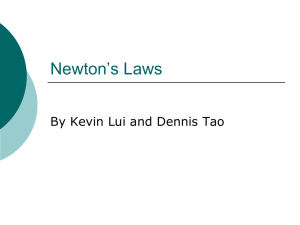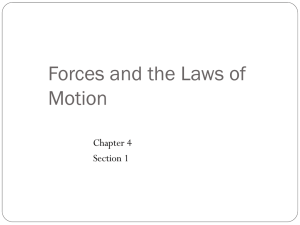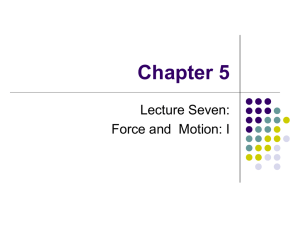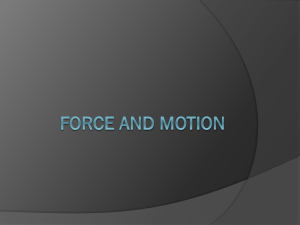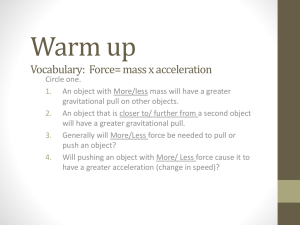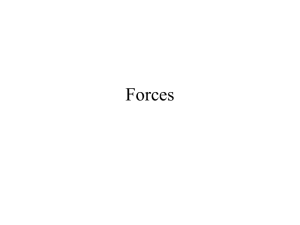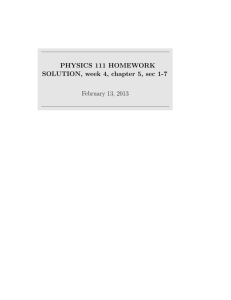File - Physics LEAP
advertisement
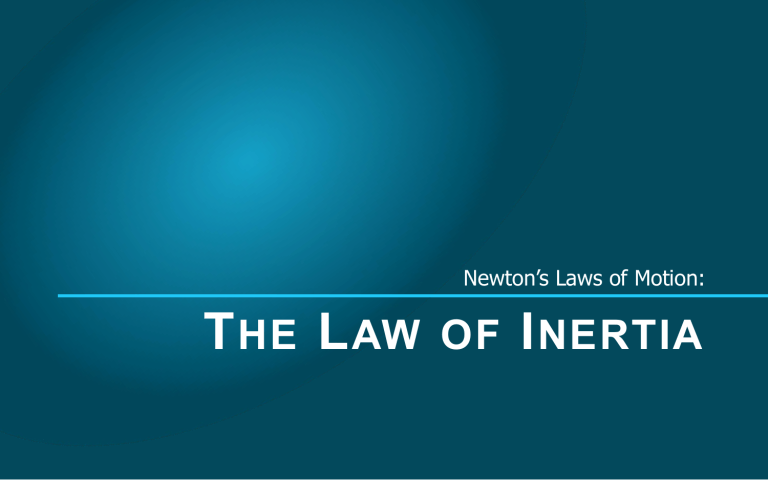
Newton’s Laws of Motion: T HE L AW OF I NERTIA Force . . . an action exerted upon a body, in order to change its state, either of rest or of moving uniformly . . . Sir Isaac Newton Newton’s First Law (The Law of Inertia) Every body perseveres in its state of rest or of uniform motion in a straight line unless it is compelled to change that state by forces impressed upon it. Systems in Equilibrium Which has greater net force? You are driving your Porsche 911 Carrera along a straight testing track at a constant speed of 150 km/h. You pass a 1971 Volkswagen Beetle doing a constant 75 km/h. For which car is the net force greater? Frame of Reference: A coordinate system plus a time scale formed by an observer Inertial Frame of Reference: A Frame of Reference with ZERO acceleration. Is the Net Force Zero? Is the Net Force Zero? Is the Net Force Zero? Is the Net Force Zero? Is the Net Force Zero? Is the Net Force Zero? Newton’s First Law normal force normal force friction force zero net force constant velocity pedal force force of gravity (weight) Newton’s Laws of Motion: T HE L AW OF A CCELERATION The FIRST LAW states that acceleration is zero if net force is zero. Equilibrium of Forces force of the hand F 0 net force is NOT zero force of gravity (weight) Object accelerates! What if net force is not zero? An external net force causes an object to accelerate. There is either a change in the magnitude of the velocity a change in the direction of the velocity or both. F ma F ma Force = mass x acceleration Acceleration is proportional to force . . . F ma Force = mass x acceleration Acceleration is proportional to force . . . . . . and inversely proportional to the mass Free Fall (again) F ma Fw F a g m F m F m Suppose you have a speeding object with velocity in +x direction. In what direction must the acceleration be in order for the object to stop? So in what direction must you apply the force? vtrain normal force friction force engine force weight of train vtrain a FSuperman applied force NET FORCE vtrain magnitude of velocity decreases! Fnet and Acceleration point in the same direction! 2ND Law of Motion Example A worker applies a constant horizontal force with magnitude 20 N to a box with mass 40 kg resting on a level floor with negligible friction. What is the acceleration of the box? a = 0.5 m/s2 Units of Force, Mass, & Acceleration Newton’s Laws of Motion: THE LAW OF ACTIONREACTION Forces Comes in Pairs Action and Reaction (Force Pair) Think of this... If we lessen the support on the book Then we feel that the book is lighter Newton’s Third Law (The Law of Action and Reaction) For every action, there is an equal and opposite reaction. Newton’s Third Law An Excellent INQUIRY, MY FRIEND! Newton’s Third Law FA on B FB on A The forces in an action – reaction pair act on different bodies! Law of Action and Reaction Imagine that you are holding a book weighing 4 N at rest on the palm of your hand. Complete the following sentences: a) A downward force of magnitude 4 N is exerted on the book by ________. the earth b) An upward force of magnitude ________ ________ 4 N is exerted on the book by your hand. c) Is the upward force in part (b) the reaction to the downward force in part NO (a)? d) The reaction to the force in part (a) is a force of magnitude ________, exerted on the ________ 4N earth by ________. the book Its direction is ________. upward e) The reaction to the force in part (b) is a force of magnitude ________ exerted on your ________ 4N hand by the book Its direction is __________. downward ________. f) The forces in parts (a) and (b) are equal and opposite first law. because of Newton's ________ g) The forces in parts (b) and (e) are equal and opposite third law. because of Newton's ________ Now suppose that you exert an upward force of magnitude 5 N on the book. h) Does the book remain in equilibrium? NO i) Is the force exerted on the book by your hand equal and opposite to the force exerted on the book by the earth? NO j) Is the force exerted on the book by the earth equal and opposite to the force exerted on the earth by the book? YES k) Is the force exerted on the book by your hand equal and opposite to the force exerted on your hand by the book? YES Finally, suppose you snatch your hand away while the book is moving upward. l) How many forces then act on the book? ONE m) Is the book in equilibrium? NO weight of book Review A 12.0-kg object undergoes an acceleration of 3.0 m/s2. What is the magnitude of the resultant force acting on it? If this same force is applied to a 9.0-kg object, what acceleration is produced? a) b) c) d) 36 N; 4.0 m/s2 4.0 N; 36 m/s2 4.0 N; 4.0 m/s2 36 N; 36 m/s2 Review A 12.0-kg object undergoes an acceleration of 3.0 m/s2. What is the magnitude of the resultant force acting on it? If this same force is applied to a 9.0-kg object, what acceleration is produced? a) b) c) d) 36 N; 4.0 m/s2 4.0 N; 36 m/s2 4.0 N; 4.0 m/s2 36 N; 36 m/s2 Review Last August 6, 2012, NASA has successfully landed the rover Curiosity on Martian soil. Curiosity weighs about 8820 N here on Earth. What should it weigh on Mars, where the free-fall acceleration is 3.75 m/s2? a)3375 N b)33075 N c)900 N d)The weight would be Review Last August 6, 2012, NASA has successfully landed the rover Curiosity on Martian soil. Curiosity weighs about 8820 N here on Earth. What should it weigh on Mars, where the free-fall acceleration is 3.75 m/s2? a)3375 N b)33075 N c)900 N d)The weight would be
